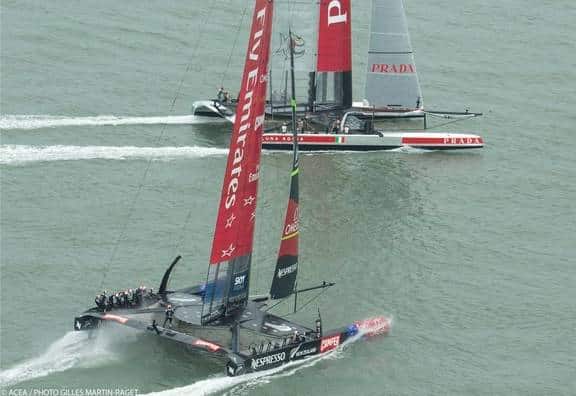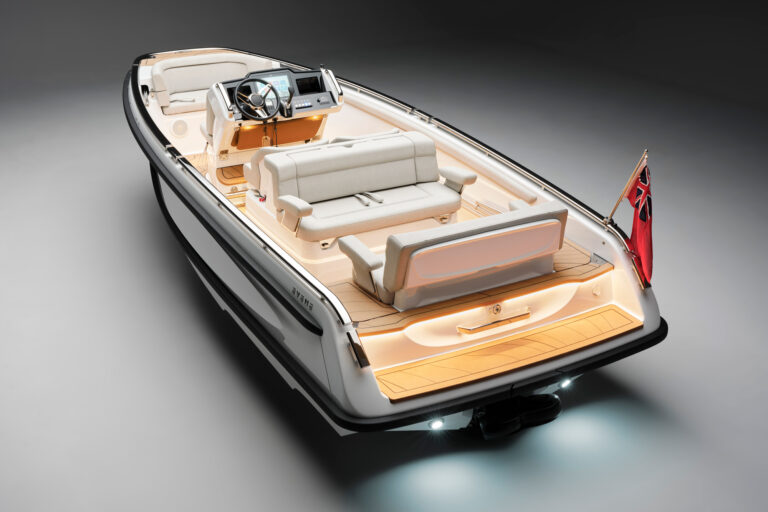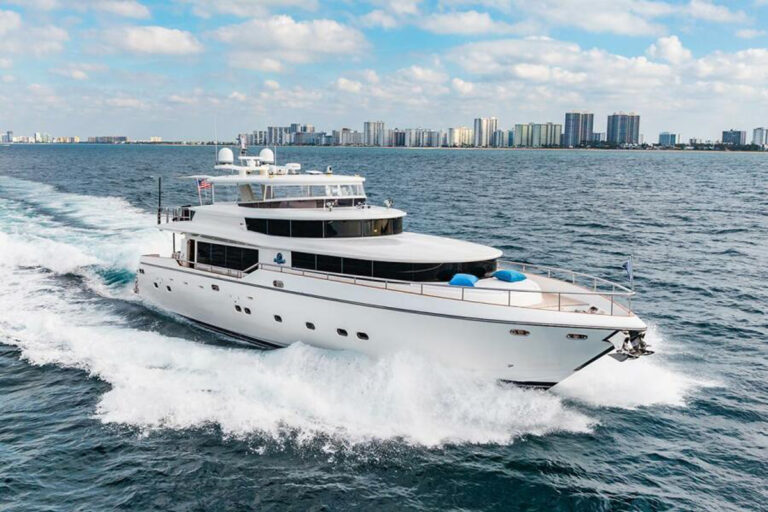
America’s Cup
America’s Cup campaigns are usually won and lost in the years and months preceding the actual racing. It’s no secret that the Cup is largely a designer’s game, fueled by two key ingredients: money and time. Obviously, the more time the designers have to tinker with their plans, in theory, the faster the yacht becomes. This is compounded by the fact that the more time the sailors have with the boat prior to racing, the more refinement can take place, encompassing everything from onboard systems and sails to crew choreography through difficult maneuvers. If a team’s money and time are well invested throughout the build-up cycle, the team’s return on investment is solid preparation—a crucial (and quantifiable) ingredient that simply can’t be faked with flashy team uniforms or slick-looking paint jobs.
To date, this year’s Louis Vuitton Cup has been a tale of preparation versus learning curves. Artemis Racing, the Challenger of Record for the 34th America’s Cup, is still limping along on one piston following their tragic capsize on May 9 that cost the life of double Olympic medalist Andrew “Bart” Simpson. Fortunately for the Swedish-flagged Artemis, their second-generation boat came online this week following extensive onshore load testing. (It’s worth noting that the other teams shared information with Artemis regarding the safe working loads that are necessary to successfully foil an AC72, sans incident, in the hopes that Artemis’s next boat will be structurally sound.)
“I don’t think anyone fully appreciates the hill Artemis Racing has climbed to get to this point,” said America’s Cup Regatta Director Iain Murray. “It’s a substantial rebuild of the team in terms of building the confidence back, the morale, and I’ve seen the momentum gathering. They’ve worked tirelessly, and I have my admiration for the way they’ve gone about it.”
As positive as this launch is, however, the fact remains that Artemis will have only a tiny fraction of the practice and refinement time that the other teams have enjoyed. While there’s no question that the team’s May 9 accident dramatically set them in arrears on the development curve, there’s also no escaping the fact that Artemis was woefully astern of the other teams from the onset, as evidenced by the problem-stricken, non-foiling first-generation boat. Then, there’s the matter of learning to fly the new boat. All of the other teams have been “flying” on foils since last summer, with the Kiwis (and, to a lesser extent, the Italians) having now publically displayed their ability to consistently execute foil-to-foil gybes. Artemis skipper Ian Percy and his crewmembers face a dramatically steep—and likely insurmountable—learning curve between now and the August 6 start of the LVC semi-finals.
Luna Rossa helmsman Chris Draper and his teammates have demonstrated their abilities to sail fast in serious conditions, as well as their rising mastery of difficult maneuvers. The team has executed a foiling gybe—considered the gold standard of AC72 maneuvers—but they are struggling with consistency and are proving slow against their Kiwi rivals, as evidenced by their most recent race, which saw the Kiwis cross the finish line a staggering seven minutes, 19 seconds ahead of their rivals. While the Italian-flagged team has been open about their performance goal of improving throughout the LVC cycle, the Italians have a long, long way to go before they can seriously threaten ETNZ.
This all bodes well for New Zealand’s aspirations of winning the Louis Vuitton Cup, but even the mighty Kiwis would still face a tough set of battles against Oracle Team USA for the actual America’s Cup (September 7-21). ETNZ clearly has no trouble executing flying gybes or dealing with equipment failures, including the broken halyard fitting that cost the team the use of their headsail during their second match race against the Italians. “We’ve never had a clip break like that in all the sailing we have done,” Barker said. “We will find out why. It could have been a race-ending failure.” Not surprisingly, ETNZ handled the situation with their world-famous professionalism. “I was impressed with the composure on board,” said team boss and grinder Grant Dalton. “We have sailed a bit without a jib, so we know it can be done. [Tactician] Ray Davies did a beautiful job of picking shifts on the second beat, so we managed pretty well.” ETNZ went on to win the race by a margin of several minutes, often proving faster under their wing alone than the Italians, who were sailing with their wing and their headsail.
As Cup geeks (myself included) will remember, the Kiwis were the first team to launch an AC72, the first to foil one of these wingsail-powered rocketships and the first to publically display their ability to stay aloft on their foils throughout a gybe, but there could be one potential downside to the Kiwi program. Following Artemis’s May 9 capsize, Murray issued a set of 37 safety recommendations, including lower maximum allowable windspeed for the starts of LVC and Cup races (down from 33 knots to 23 knots). Because of this, it’s possible that the Kiwis will find themselves sailing aboard a heavier-duty boat than they otherwise might have designed, given the new wind ranges.
Here, Oracle commands a massive advantage, as they have two working AC72s and are the only team that doesn’t have to compete in the Louis Vuitton Cup, which is being sailed during the windy months of July and August. Oracle can optimize their boats to the new wind ranges, perhaps tuning one AC72 for light-air sailing while keeping the other boat reserved for windier conditions.
And while Oracle has a distinct design- and build-time edge, ultimately, each team’s sailors still need to be able to bring a boat through its racecourse paces faster than their rivals. The billion-dollar question thus emerges: Will ETNZ’s “battle-hardening” in the LVC against two soft (to varying degrees) opponents match the level of in-house preparation that Oracle Team USA can generate using their well-staffed and well-funded two-boat program?
While the answer to this big question won’t be known until early September, Cup fans can expect another interesting on-the-water tussle between ETNZ and Luna Rossa this Sunday. In the meantime, Luna Rossa and ETNZ are both expected to sail more solo saps around the course on Thursday and Saturday (respectively) as Artemis Racing will not be racecourse-ready for some time.
David Schmidt is a Seattle-based international yachting journalist, the Electronics Editor at Yachting Magazine and a lifelong sailor.









